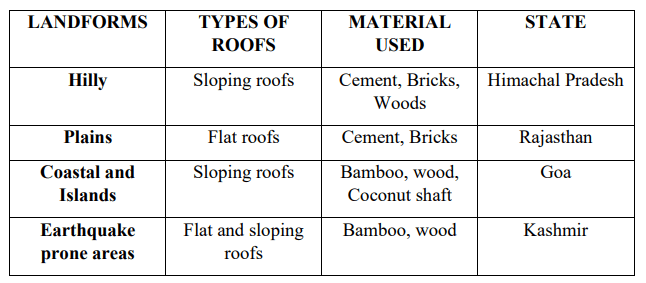If you are looking for DAV Class 5 SST Chapter 3 Question Answer Variation in Shelters of we and our world social science book, then you are at right place. Here at solutiongyan.com, Class 5 Social Science chapter 3 exercises provided at the end of the chapter will be a useful resource for DAV Class 5 students.
Here, we provide complete solutions of DAV Class 5 SST Chapter 3 Variation in Shelters of We and Our World SST Textbook. These exercise of sst chapter 3 contains five questions and the answers to them are provided in the DAV Class 5 SST Chapter 3 Question Answer Human Variation in Shelters.

Solutions of DAV Class 5 SST chapter 3 Variation in Shelters is help to boost the writing skills of the students, along with their logical reasoning. Students of class 5 can go through Social Science chapter 3 solution to learn an effective way of expressing their answer in the dav class 5 sst exam.
DAV Class 5 SST Chapter 3 Variation in Shelters Solutions
DAV Class 5 Social Science Chapter 3 Variation in Shelters Solutions is given below. Here DAV Class 5 SST chapter 3 question answer is provided with detailed explanation. i.e. Answer briefly, Answers the following questions, Tick the correct option, Fill in the blanks, etc.
Highlights
- Tick the correct option
- Fill in the blanks
- State whether True or False
- Answer briefly
- Answers the following questions
DAV question answer of Class 5 of We and Our World Social Science Textbook is the best source for the students to self-analyse their performance. DAV Class 5 students are more likely to score good marks in SST (Social Science) exam if they practise DAV Class 5 SST Chapter 3 Question Answer Variation in Shelters regularly.
DAV Class 5 SST Chapter 3 Question Answer
A. Tick the correct option:
1. The number of Bhimbetka rock shelters is-
Answer: 700
2. Bamboo and wooden houses are found in-
Answer: Earthquake prone areas
3. The earliest form of shelter for man were-
Answer: Caves
4. Flat roof houses are found in regions of-
Answer: High temperature
5. The volume of radio/television at night should be kept-
Answer: Low
B. Fill in the blanks:
1. We live in society because we are ___________ on others for fulfillment of our needs.
2. Houses in hilly areas have ___________ roofs.
3. Stilt houses protect the ___________ from wild animals.
4. You can organise ___________ pool with neighbours.
5. In cities, flats are common because of ___________ land and many people.
Answer: (1) dependent (2) sloping (3) inhabitants (4) car (5) limited
C. State whether True or False:
1. Huts were the earliest form of man-made shelter.
2. Bhimbetka rock shelters are 9000 years old.
3. The houses in the hilly areas have flat roof.
4. We must never help our neighbours in case of emergency.
5. Most people do not hesitate to throw garbage on street.
Answer: (1) False (2) True (3) False (4) False (5) True
D. Answer briefly:
1. What was the earliest form of shelter?
Answer: Caves were the earliest form of shelter.
2. What are the walls of huts made of in villages?
Answer: The walls of huts in villages are made of mud.
3. Why are some houses built with thick walls and flat roofs?
Answer: Some houses are built with thick walls and flat roofs to keep them cool in summer.
4. Give two advantages of high-rise apartments.
Answer: Two advantages of high-rise apartments are:
- These apartments require limited space.
- It offers accommodation to many people in less space.
5. What is the advantage of Neighbourhood Watch Plan?
Answer: It is a wonderful way of crime prevention and ensuring safety of residents, specially the elderly members and children.
E. Answer the following questions:
1. What information do we get from Bhimbetka rock shelters?
Answer: We get lot of information from Bhimbetka rock about the life, tools and implements of the early man. It also connects us to the prehistoric man.
2. List the changes that occurred in the life of man when he became a food producer.
Answer: Many changes occurred in the life of man when he became food producers:
- They started living settled life.
- Started building hut near water bodies.
- Started agriculture.
- Started eating cooked food.
3. Give three reasons for regional variation in houses.
Answer: The three reasons for regional variation in houses are:
- Landforms
- Climate
- Material available in that area
- Money in hand
4. What are the responsibilities of a good neighbour?
Answer: The responsibilities of a good neighbour are as follows
- To keep the volume of radio and television low at night.
- Avoid using noisy equipments at night.
- Must follow neighbourhood watch plan.
- Always try to keep surrounding clean as our home.
5. Complete the table below:


Good app
Excellent
Excellent…….Thanks for Questions and Answers It helped very much in exams
This is the only app that i liked that much . I love it
❤
Nice this is best study
Good App
Very Very nice your answer
THANKS SIR ???? ????